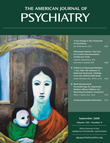The American Psychiatric Publishing Textbook of Psychiatry, Fifth Edition
The American Psychiatric Publishing Textbook of Psychiatry, Fifth Edition , edited by Robert Hales, Stuart Yudofsky, and Glen Gabbard, is an outstanding update to this volume, which first appeared more than two decades ago. It has become a standard reference for practicing psychiatrists, psychiatric residents, and medical students, and the newest version would be a welcome addition to any medical library.
Since the last edition, which was published in 2000, the field of psychiatry has continued to expand at an astonishing rate. Nevertheless, the editors have attempted to contain relevant advances to a single volume of 1,818 pages without compromising the book’s value as a reference and review document. The major changes are evident in the first two parts. In addition to a chapter on “The Psychiatric Interview and Mental Status Examination,” Part I includes chapters on “Laboratory Testing and Imaging Studies in Psychiatry” and “The Role of Psychiatric Measures in Assessment and Treatment.” In the former, the authors describe the reasons for and the utility of various laboratory tests and imaging studies, with excellent charts indicating the types of assays which can be used along with the usual reference ranges and indications. There is a section on the laboratory approach to specific clinical situations, such as new-onset psychosis, mood disorders, altered mental status, and cognitive decline. In addition, there is a section on psychotropic drug metabolism by specific P450 enzymes, with a discussion of the new field of phenotype- and classification-specific drug metabolism, as well as selected investigational biologic and genetic markers. The authors also provide a useful comparison of CT and MRI scans, as well as the functional neuroimaging modalities of SPECT and PET. There is particularly helpful guidance for the clinician treating patients suffering from strokes, traumatic brain injury, cognitive decline, and epilepsy.
The chapter on “The Role of Psychiatric Measures in Assessment and Treatment” provides a review of instruments available for the assessment of DSM-IV axis I disorders and related symptoms. This is especially important as the field advances with the rest of medicine in an effort to focus on the evidence basis of disorders and outcomes of various types of treatment. The authors provide clear descriptions of relevant instruments, such as the Structured Clinical Interview for DSM (SCID) in its various versions, the SCL-90, the Brief Psychiatric Rating Scale (BPRS), and the MMPI. Charts with instruments for the assessment of specific symptom areas such as substance abuse, affects, suicidal behavior, and thought disorders are also provided. The chapter includes a review of scales available to examine various cognitive domains, as well as the assessment of personality traits and disorders and an assessment of psychodynamics, environmental demands, and social adjustment.
Part II is an overview of “Basic Science and Development.” It includes two new chapters, which provide reviews of structure and function from the cellular to the macro-anatomical level. The chapter on “Cellular and Molecular Biology of the Neuron” provides a review of neuronal structure and function, a discussion of neuronal excitability and molecular events in the synaptic vesicle, and a neurodevelopmental approach to understanding psychiatric disorders through a review of the development of neurons, neurogenesis, proliferation, migration, and cell fate.
“Neuroanatomy for the Psychiatrist,” an exciting new addition to the textbook, provides an overview of cerebral structure and function in a clear and concise format which is easy to understand and relevant to the clinical practice of psychiatry. There are excellent diagrams with views of brain areas responsible for different attributes, such as initiation and synchronization of speech and complex movements, naming, focused attention, verbal intellect, and verbal memory management. A series of tables include functions of interest in the various areas of the brain and a summary of common consequences of injury to specific regions.
Part III, “Psychiatric Disorders,” is essentially unchanged in organization, but all chapters have been revised and updated. The chapter on “Sexual and Gender Identity Disorders” has been expanded into two chapters, one on “Human Sexuality and Sexual Dysfunctions” and another on “Gender Identity Disorders and Paraphilias.”
Part IV, “Psychiatric Treatments,” has been expanded with the addition of several new chapters. These include a chapter on “Nonpharmacological Somatic Treatments,” such as transcranial magnetic stimulation and vagal nerve stimulation, as well as a chapter on “Brief Psychotherapies.” The chapter on “Psychoanalysis, Psychoanalytic Psychotherapy, and Supportive Psychotherapy” has been split into two chapters, one on “Psychodynamic Psychotherapy” and another on “Supportive Psychotherapy.”
Part V focuses on “Special Patient Populations” and includes two new chapters, one on the “Treatment of Seniors” (instead of the usual chapter on geriatric psychiatry) and another on the “Treatment of Gay, Lesbian, Bisexual, and Transgender Patients.”
The book has a much cleaner, clearer look with a better layout of chapters. Most chapters include excellent tables and charts and all include a final segment called “Key Points,” as well as suggested readings, online resources, and references. Overall, this book is an outstanding addition to our field and a reference that every practicing psychiatrist and trainee should include in his or her personal library.



